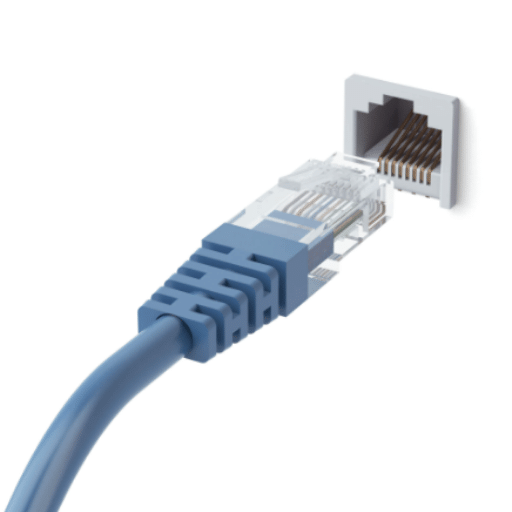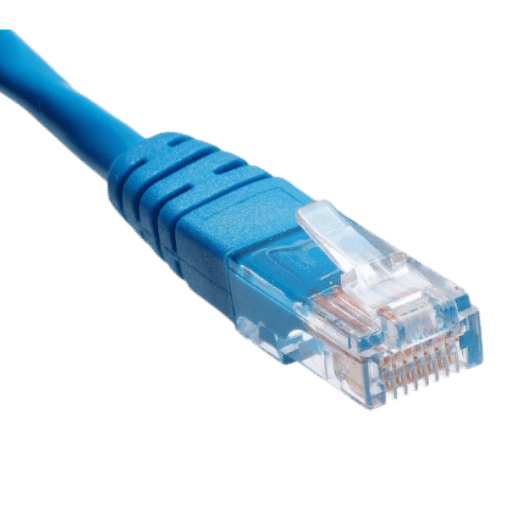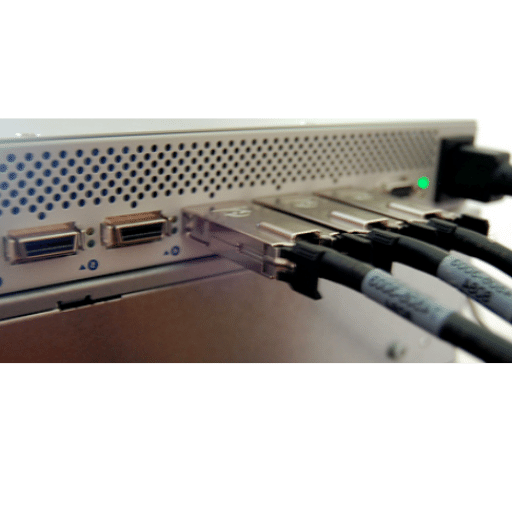InfiniBand is a high-speed networking and input/output (I/O) technology developed in the late 1990s as a successor to previous interconnect technologies such as PCI and SCSI. It was designed to overcome the limitations of these technologies and provide a more efficient, scalable, and low-latency fabric for connecting servers, storage systems, and other computing devices in data centers and high-performance computing (HPC) environments.

InfiniBand is a switched fabric architecture that uses a point-to-point link between devices, allowing for high bandwidth and low latency. It uses a channel-based approach to data transfer where data is broken down into smaller packets called “data packets” and transferred over the fabric. The architecture also enables parallel processing, where multiple data packets can be transmitted simultaneously, resulting in higher performance.
InfiniBand offers several advantages over traditional networking technologies such as Ethernet. For one, it delivers significantly higher bandwidths, with speeds of up to 200 Gb/s currently available. In addition, InfiniBand has much lower latency than Ethernet, making it ideal for high-performance computing workloads where data needs to be processed quickly.
Another advantage of InfiniBand is its scalability – it supports tens of thousands of nodes in a single fabric – making it an ideal choice for large data center environments. It also offers high reliability and availability through its redundant mesh topology, which ensures that the fabric remains up and running even during connectivity issues.
Recommended Reading: What is a Data Center Network? How to manage a data center network
The InfiniBand network architecture consists of several layers, each of which performs specific functions to ensure efficient data transfer across the fabric. These layers include:
Physical Layer: This layer handles the physical connection between devices and ensures that data is transmitted and received correctly.
Data Link Layer: This layer provides reliable data transfer using acknowledgments and checksums to detect and correct errors. It also manages flow control to ensure that data is transmitted at an appropriate rate.
Network Layer: This layer provides routing of data packets across the fabric and management of traffic and congestion control.
Transport Layer: This layer provides reliable end-to-end delivery of data and ensures that data is delivered in the correct order.
InfiniBand switches and adapters are essential components of an InfiniBand network. InfiniBand switches are used to route data between devices in the fabric, and they typically have several ports that enable multiple devices to be connected to the material. InfiniBand adapters, on the other hand, are installed in server or storage systems to provide connectivity to the InfiniBand fabric.
These switches and adapters are designed specifically for InfiniBand. They are optimized for low-latency, high-bandwidth data transfer, making them well-suited for HPC environments and other data-intensive applications.
InfiniBand is a standardized technology with several industry organizations involved in its development and maintenance. The InfiniBand Trade Association (IBTA) oversees the development of the InfiniBand specification and ensures that it remains up-to-date with the latest technology advances. The IBTA also manages the interoperability testing program, which verifies that InfiniBand products from different vendors can work together in a single fabric.
InfiniBand is currently available in several versions, including InfiniBand Single Data Rate (SDR), Double Data Rate (DDR), Quad Data Rate (QDR), and Eight Data Rate (EDR). Each iteration has seen improvements in bandwidth, latency, and other performance metrics, making InfiniBand an increasingly attractive option for data center and HPC environments.
Ethernet is a widely used technology for local area networks (LANs). Ethernet is a system of wiring and data protocols that provide a consistent and reliable method for transmitting data packets between connected devices. It uses a Physical Layer (PHY) and Media Access Control (MAC) protocol to send information over copper or optical cables in a star-shaped topology. Ethernet is used in almost all industries, from small applications to large-scale networks.

The first Ethernet system was invented in 1973 by Bob Metcalfe at Xerox’s Palo Alto Research Center. Metcalfe’s original Ethernet protocol, 10Base5, was designed for a 10 Mbps connection over a thick coaxial cable. Ethernet technology has evolved over the years, and there are currently many other options with higher speeds, including 40GB, 100GB, and 400GB Ethernet.
Ethernet packets consist of a header and a data payload. The title includes the source and destination addresses, while the data payload carries the information transmitted. MAC addresses assign every device connected to a network with a unique identifier, which is then used to establish a connection.
Ethernet technology provides many benefits over other network technologies, including:
Cost-effective: Ethernet allows for low-cost implementation and maintenance of networks.
Scalability: Ethernet systems are scalable and can be easily upgraded as the need for bandwidth increases.
Reliability: Ethernet has proven to be highly reliable, with very high uptime and low error rates.
Security: Ethernet-based networks provide higher protection than other networking technologies due to various security features.
Compatibility: Ethernet technology is compatible with various devices, making it an ideal solution for shared networks.
Ethernet networks are designed around a hub and spoke architecture that uses switches, routers, and seats to connect devices in a star-shaped topology. The Ethernet architecture ensures that data packets are transmitted and received accurately between connected devices.
Ethernet switches, and adapters are vital in Ethernet network architecture, providing connectivity between devices. Ethernet switches connect multiple devices to form a network. They reduce data collisions and help to prevent network congestion. Ethernet adapters (also called Network Interface Cards or NICs) are devices that are used to connect computers and other devices to an Ethernet network. They translate the digital signal into an electrical signal that can be transmitted over the web.
Ethernet protocol is the rules and procedures governing communication across Ethernet networks. Ethernet communication is based on IEEE (Institute of Electrical and Electronics Engineers) 802.3 Ethernet networking standards. The IEEE provides a framework for developing specifications for Ethernet protocol and interface hardware. The result of Ethernet standards ensures that networking equipment and devices from different manufacturers can communicate.
The latest development in Ethernet technology is known as the 25 Gigabit Ethernet (25GbE). This technology uses a single connection to transfer data at 25 gigabits per second (Gbps). It is designed to support next-generation data center environments with ever-increasing bandwidth demands.
Ethernet technology has evolved tremendously since its inception, from 10Mbps Ethernet in the early 1980s to 400GB Ethernet, the latest iteration. With its robust and scalable architecture, Ethernet is the backbone of most networks, enabling fast, reliable, and economical communication.
InfiniBand and Ethernet are two advanced networking technologies widely used in the computer industry. InfiniBand is a high-speed, low-latency interconnect technology for server clusters, data centers, and high-performance computing environments. On the other hand, Ethernet is a widely used networking protocol that supports many applications, including home and office networking, network storage, and data center networking.
When comparing InfiniBand and Ethernet, latency is one of the most significant differences between the two technologies. Latency refers to the time data travels from a sender to a receiver within a network. InfiniBand has the lowest latency of any interconnect technology available, with round-trip latencies ranging from two to ten microseconds. Ethernet has higher latency, with round-trip latencies ranging from 20 to 200 microseconds.
InfiniBand also has a significant performance advantage over Ethernet. InfiniBand can deliver higher data transfer rates of up to 200 Gb/s, while the fastest Ethernet Ethernet speed currently available is 100 Gb/s. In addition, InfiniBand supports Remote Direct Memory Access (RDMA), which allows data to be transferred directly between servers’ memory without involving the CPU. This eliminates the need for network protocol processing and leads to higher performance. Ethernet does not support RDMA and relies on the CPU’s involvement in data transfers, leading to lower performance levels.
Scalability is another crucial factor in comparing InfiniBand and Ethernet. InfiniBand is highly scalable, which makes it an ideal choice for large server clusters and high-performance computing applications. InfiniBand’s scalability is achieved using a switch-based fabric architecture that can support millions of nodes, allowing it to scale seamlessly as the network grows. On the other hand, Ethernet has inherent scalability limitations due to its shared medium nature. As a result, Ethernet is best suited for smaller networks, and its performance may degrade as the web grows.
InfiniBand and Ethernet are used in various applications, depending on their unique advantages. InfiniBand is ideal for high-performance computing and data center applications that require low latency and high-bandwidth connectivity, such as scientific simulations, genome sequencing, and financial analysis. Ethernet is commonly used in office and home networking, network storage systems, and internet connections. Ethernet is also well-suited for small-scale data center applications that do not require high-performance connectivity.
In recent years, the trend in the server industry has been towards using Ethernet, which is more widely adopted and proven reliable in various applications. In contrast, InfiniBand is mainly used in specialized applications that require high performance and low latency. However, InfiniBand is seeing renewed interest due to the emergence of new AI/ML applications and the demand for higher-performance computing. The future of InfiniBand and Ethernet is likely to be influenced by these and other emerging applications, as well as the development of new technologies, such as the use of Light Peak technology, which can provide Ethernet with increased bandwidth levels of up to 800 Gb/s.
Recommended Reading: Data Center Network Architecture
Artificial intelligence (AI) has become an increasingly important aspect of data center networking in recent years. While Ethernet has long been the standard for networking in data centers, InfiniBand has emerged as a powerful, particularly well-suited alternative for high-performance computing (HPC) and AI workloads.
InfiniBand is a high-speed networking technology that was initially designed for HPC clusters. It has become increasingly popular in recent years for AI workloads due to its low-latency, high-bandwidth capabilities. InfiniBand is particularly well-suited for parallel computing, an essential component of HPC and AI workloads.
Ethernet is the traditional networking technology used in data centers. It is a low-cost, high-bandwidth technology widely deployed in enterprise environments. Ethernet operates at a slower speed than InfiniBand, but it can still handle most data center workloads.
Data center network architecture typically consists of a core, distribution, and access layer. The core layer provides high-speed connectivity for all devices in the data center, while the distribution layer provides connectivity between the core and access layers. The access layer is where end-user devices connect to the network. Ethernet is widely used at all layers of the data center network architecture.
When it comes to HPC workloads, InfiniBand has several advantages over Ethernet. First and foremost, InfiniBand offers much lower latency than Ethernet. This is critical for HPC workloads that require fast inter-node communication. InfiniBand also provides higher bandwidth than Ethernet, making it well-suited for HPC applications that require large amounts of data to be transferred between nodes.
AI workloads depend on high-performance computing resources to process large amounts of data quickly and accurately. InfiniBand is particularly well-suited for AI workloads due to its low latency and high bandwidth capabilities. It enables the rapid transfer of large amounts of data between nodes in a cluster, which is essential for AI models that require distributed computing.
InfiniBand HDR (High Data Rate) is the latest version of InfiniBand technology, offering much faster speeds than its predecessor. HDR offers up to 200 Gbps per port speed, making it an ideal choice for AI workloads requiring high bandwidth and low latency. 200G InfiniBand is a new technology that builds on the capabilities of HDR, offering even higher speeds and lower latencies for AI and HPC workloads.
Recommended Reading: Understanding InfiniBand: A Comprehensive Guide

Network protocols and adapters enable effective communication and data transfer across complex networks. In the case of InfiniBand, network adapters are responsible for providing high-speed connections between the server and the network fabric. The InfiniBand architecture supports a range of adapter technologies, including host channel adapters (HCAs), target channel adapters (TCAs), and switch channel adapters (SCAs). Each of these adapter types plays a unique role in facilitating communication and data transfer between different components within the network.
Similarly, in Ethernet, network adapters function as the interface between the network and the computing system. Ethernet adapters, known as network interface cards (NICs), provide connectivity between the server and the network infrastructure while supporting high-speed data transfers. Ethernet adapters come in various forms, including copper-based, fiber-based, and wireless, and provide multiple bandwidth options.
InfiniBand and Ethernet utilize network protocols to cater to their unique application requirements. InfiniBand uses a low-latency, high-speed protocol called the InfiniBand architecture (IBA). The IBA is intended to efficiently transmit bulk data, making it an ideal choice for HPC environments requiring high-speed, low-latency communication.
On the other hand, Ethernet employs the Transmission Control Protocol (TCP)/Internet Protocol (IP) suite to provide network connectivity and data transfer. TCP/IP is a widely adopted protocol compatible with various application environments. Ethernet also supports protocols like the User Datagram Protocol (UDP) and Internet Protocol Security (IPSec).
Ethernet switches and InfiniBand switches are network devices that enable communication between computing resources, storage systems, and other network components. However, while both switches perform the same fundamental task, their underlying architectures and functionality differ significantly.
Ethernet switches are designed to provide connectivity to end-user devices and servers, making them ideal for enterprise-level networking. Ethernet switches operate at the networking layer of the OSI model, which means they use IP-based protocols to establish communication between network devices.
In contrast, InfiniBand switches are designed to provide high-performance, low-latency connectivity between HPC clusters, making them ideal for data center and supercomputing environments. InfiniBand switches operate at the data link layer of the OSI model, which means they utilize a lower-level protocol than Ethernet switches. This allows them to provide faster transmission speeds and lower latencies than Ethernet switches.
InfiniBand supports a range of network adapter technologies, each of which has a unique role in supporting fast and efficient communication between network components. Host Channel Adapters (HCAs) connect servers to the InfiniBand network through PCIe interfaces. Target Channel Adapters (TCAs) provide connectivity to storage devices, while Switch Channel Adapters (SCAs) connect switches and routers to the network.
InfiniBand also supports Remote Direct Memory Access (RDMA), a technology that allows network applications to access data in remote storage devices without going through the operating system’s protocol stack. RDMA facilitates faster data transfer and reduced CPU overhead, making it an integral component of InfiniBand’s high-performance architecture.
The benefits of InfiniBand and Ethernet as interconnect technologies are highly dependent on the application environment in which they are used. InfiniBand’s low-latency, high-speed architecture is ideal for data center and HPC applications that require fast, efficient communication between many computing elements.
In contrast, Ethernet’s ubiquitous nature makes it the preferred choice for most enterprise-level network environments. Ethernet’s flexibility and scalability make it an ideal choice for cloud-based applications and data center infrastructures that balance a range of workloads.
As the demand for high-speed data transmission continues to surge, advances in network interconnect technology are becoming increasingly necessary. The emergence of new protocols, such as Ethernet’s 400 Gigabit Ethernet (GbE), provides higher throughputs than ever, resulting in massive improvements in data center efficiency and processing power.
Recommended Reading: EPON, a long-haul Ethernet access technology based on fiber optic transport network

A: InfiniBand and Ethernet are network technologies but have some key differences. While Ethernet is a widely-used networking standard that has existed for a long time, InfiniBand is a high-speed network technology specifically designed to provide low latency and high-bandwidth communication.
A: InfiniBand can offer significantly higher speeds compared to traditional Ethernet. While Ethernet typically operates at speeds of 1Gbps, 10Gbps, or 100Gbps, InfiniBand can provide up to 200Gbps or even higher rates.
A: InfiniBand has several advantages over Ethernet. It offers lower latency, higher bandwidth, and better scalability, making it suitable for high-performance computing environments. InfiniBand also supports remote direct memory access (RDMA), allowing data to be transferred between systems without involving the CPU.
A: Yes, InfiniBand is an open standard. It is developed and maintained by the InfiniBand Trade Association (IBTA), which comprises companies from the technology industry.
A: Yes, InfiniBand and Ethernet can coexist in the same network. Many modern data centers use both technologies to optimize performance and meet different networking needs.
A: Yes, there are different types of Ethernet, such as 10BASE-T, 100BASE-TX, and 1000BASE-T. These refer to different versions and speeds of Ethernet technology.
A: InfiniBand HDR (High Data Rate) is the latest iteration of the InfiniBand standard. It offers even higher speeds and improved performance compared to previous generations.
A: InfiniBand is switch-based and uses a different packet handling mechanism than Ethernet. InfiniBand uses remote direct memory access (RDMA) to directly transfer data between systems, whereas Ethernet relies on the traditional packet switching approach.
A: Many intelligent devices rely on Ethernet for interconnection and communication. Ethernet is a widely used and well-established networking technology that supports various instruments and applications.
A: InfiniBand provides high bandwidth and low latency, which can contribute to improved network reliability. With its fast speeds and advanced features like RDMA, InfiniBand can help reduce network congestion and enhance overall system performance.